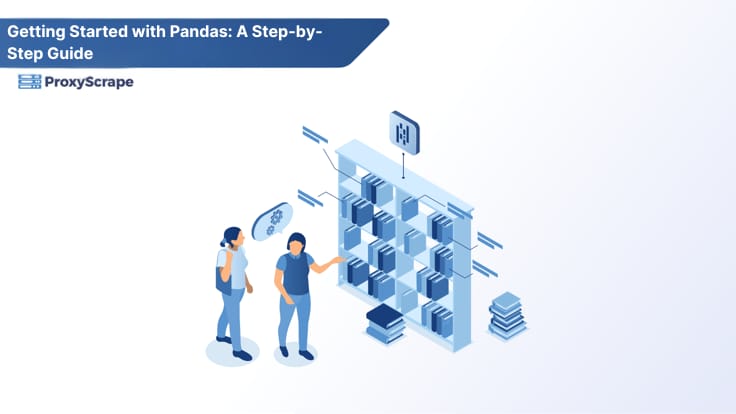Getting Started with Pandas: A Step-by-Step Guide

If you're new to Python and web scraping, chances are you've come across the term "Pandas." But what exactly is Pandas, and why is it such an essential tool in the field of data analysis and extraction? This guide is here to take you from a beginner to a confident user of Pandas, step by step. By the end of this article, you'll understand what makes Pandas so powerful and how to start using it to work with scrapped data effectively.
What is Pandas and Why is It Useful?
Pandas is an open-source library for Python that simplifies working with structured data. Whether you're analyzing spreadsheets, cleaning data, or crunching numbers on large datasets, Pandas equips you with the tools to do so in a clean, efficient, and Pythonic way. Its ease of use and versatility have made it a critical tool in processing data. If you're a beginner, you'll find Pandas to be your go-to for handling everything from simple data manipulations to more complex transformations.
Key Features of Pandas:
- Handle large amounts of data with ease.
- Perform operations like filtering, grouping, and reshaping datasets efficiently.
- Integrate seamlessly with other Python libraries such as NumPy, Matplotlib, and Scikit-learn.
If you've worked with spreadsheets like Excel or Google Sheets, you'll find Pandas to be a game-changer for handling larger data with programmatic convenience.
Installing Pandas in a Few Simple Steps
Before we get into the details, let's start by installing Pandas on your machine. Here’s how to do it:
1. Install Python
Make sure Python is installed on your system. You can download it from python.org.
2. Install Pandas via pip
Open your terminal or command prompt and run the command:
pip install pandas3. Verify Installation
Test your installation by firing up a Python environment:
import pandas as pd
print(pd.version)If the version number displays without errors, you're ready to roll!
Understanding Data Structures in Pandas
At the heart of Pandas are two main data structures—Series and DataFrames . Let's break these down:
Series
A Series is a one-dimensional data structure that can hold data of any type (integer, float, string, etc.), similar to a list or a column in a spreadsheet. Each element in a Series is associated with an index.
Example:
import pandas as pd
s = pd.Series([10, 20, 30, 40])
print(s)
Output
0 10
1 20
2 30
3 40
dtype: int64
DataFrame
A DataFrame is a two-dimensional labeled data structure, similar to a table in a database or an Excel sheet. It consists of rows and columns, offering immense flexibility for data manipulation.
Example:
data = {'Name': ['Alice', 'Bob'], 'Age': [25, 30]}
df = pd.DataFrame(data)
print(df)
Output:
Name Age
0 Alice 25
1 Bob 30
Reading Data with Pandas
One of the most common tasks in data analysis is reading data from various external sources. Pandas makes this easy.
Example 1: Reading CSV Files
df = pd.read_csv('data.csv')
print(df.head()) # Display the first 5 rows
Example 2: Reading Excel Files
df = pd.read_excel('data.xlsx', sheet_name='Sheet1')
Example 3: Other Formats (SQL, JSON, etc.
Pandas also supports importing SQL queries, JSON files, and more
df = pd.read_json('data.json')
Performing Basic Operations
Once you've loaded data into a DataFrame, here are some foundational operations you can perform:
Selecting Columns and Rows
# Select a single column
df['column_name']
# Select multiple columns
df[['col1', 'col2']]
Filtering Data
# Filter rows where age > 25
filtered_df = df[df['Age'] > 25]
Sorting Data
# Sort by Age in descending order
sorted_df = df.sort_values('Age', ascending=False)
Cleaning Your Data
Real-world datasets are often messy. Here's how Pandas can help clean them:
Handling Missing Data
# Fill missing values with 0
df.fillna(0, inplace=True)
# Drop rows with missing values
df.dropna(inplace=True)
Removing Duplicates
df = df.drop_duplicates()
Conclusion
Pandas is a game-changer when it comes to handling and structuring scraped data efficiently. In web scraping, raw data is often unstructured, messy, and filled with missing or duplicate values. With Pandas, you can quickly clean, filter, and organize this data into a structured format that’s easier to analyze or export. Mastering Pandas will help you turn raw scraped data into valuable insights with minimal effort.
Ready to move to the next step? Check out this blog and discover the top Pandas functions every beginner should know to enhance your data handling skills!